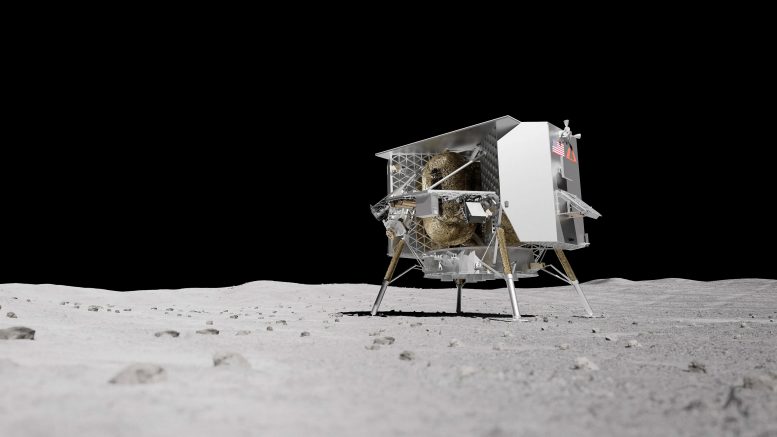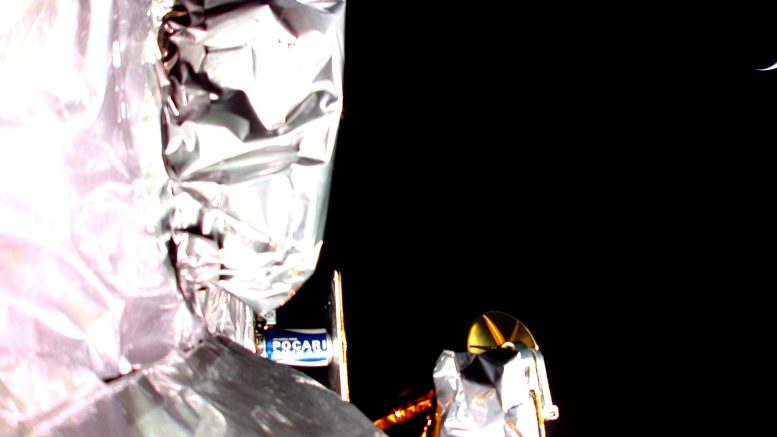

NASA and Astrobotic’s Peregrine lunar lander was set for a controlled re-entry into Earth’s atmosphere, having successfully collected space data despite not landing on the Moon. (Artist’s concept.) Credit: SciTechDaily.com
NASA and Astrobotic’s Peregrine Mission One, initially intended for a lunar landing, was put on a controlled trajectory for re-entry into Earth’s atmosphere on Thursday at 4 p.m. EST. The re-entry point was redirected to the South Pacific to ensure safety. Despite not landing on the Moon, NASA instruments on the spacecraft have successfully collected valuable data on radiation and chemical compounds in space.
Carrying NASA science and technology, Astrobotic’s Peregrine lunar lander remained on a trajectory toward Earth and was predicted to re-enter Earth’s atmosphere today at about 4 p.m. EST.
To ensure a controlled, safe re-entry, Astrobotic in coordination with NASA and other government agencies, changed the spacecraft’s projected re-entry location to a remote area of the South Pacific. No ground hazards are anticipated.
Astrobotic evaluated several options with NASA consultation to end the mission safely and determined that the best approach for minimizing risk and ensuring responsible disposal of the spacecraft would be Peregrine’s re-entry into Earth’s atmosphere, likely causing the spacecraft to burn up.


Peregrine is Astrobotic’s small-class lunar lander. It was poised to carry out one of the first commercial missions to the Moon, and be among the first American spacecraft to land on the Moon since the Apollo program. Credit: Astrobotic Technology
After Astrobotic confirmed Astrobotic’s Peregrine Mission One would not be a soft-landing on the Moon, NASA science teams adjusted their procedures to collect data in space near the Moon. All NASA payloads designed to power on have received power and collected data, including: Linear Energy Transfer Spectrometer (LETS), Near-Infrared Volatile Spectrometer System (NIRVSS), Neutron Spectrometer System (NSS), and the Peregrine Ion-Trap Mass Spectrometer (PITMS). Since the LRA (Laser Retroreflector Array) instrument is a passive experiment designed for the lunar surface, it cannot conduct any operations in transit.
Although interpreting the results will require some time, preliminary data suggests that the instruments have collected measurements of the radiation environment and chemical compounds in the lander vicinity, a positive sign that the instruments survived the harsh conditions of space and are functioning as expected.
The NSS and LETS experiments gathered measurements of the radiation environment in interplanetary space around the Earth and the Moon. The two instruments collected different components of the radiation spectrum, providing complementary insights into the galactic cosmic ray activity and space weather resulting from solar activity.


An image captured in space from Peregrine’s journey. The curved sliver in the upper right corner is Earth. The camera that took this image is located on the bottom of one of Peregrine’s payload decks. Just left of center in the image is the DHL MoonBox payload covered in MLI, which contains hundreds of thousands of messages from the people of Earth. Visible to the right of MoonBox and near the bottom center of the photo is Astroscale’s Pocari Sweat Lunar Dream Time Capsule – this was the first payload under contract with Astrobotic and contains messages from children around the world. The bottom center right of the image shows one of Peregrine’s landing legs obscured by the electrical interface where we were connected with the launch vehicle. Credit: Astrobotic
The PITMS operations were successful, and the team was able to acquire multiple mass spectra both before and after opening the instrument’s protective dust cover. The data confirm PITMS was in good health and that the instrument could provide useful measurements of lunar volatile compounds on future missions. The PITMS is a partnership between NASA; The Open University; RAL Space; and ESA (European Space Agency).
NIRVSS also successfully powered on and collected images, spectra, and additional data around the lander. A variety of chemical compounds were detected in the NIRVSS spectra which the team currently attributes to lander outgassing and leaked fuel. The team also refined their process for capturing spectra, or intensity of light being emitted, and images while at low data rates. Some of this work validated data processing methods, tools, and operational procedures, all of which will improve NASA’s ability to map the lunar surface in the future.
NASA will join Astrobotic during their media telecon at 1 p.m. EST on Friday, January 19, to provide an end of mission update. Audio of the call will stream live on NASA’s website.
